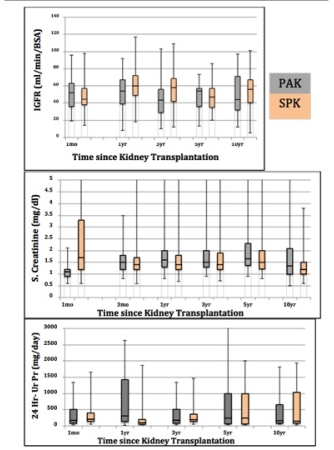Long Term Follow Up Reveals Satisfactory Renal Outcome in Pacreas After Kidney Transplantation (PAK)
Mayo Clinic, Rochester.
Meeting: 2015 American Transplant Congress
Abstract number: 230
Keywords: Graft function, Kidney/pancreas transplantation, Pancreas transplantation, Renal function
Session Information
Session Name: Concurrent Session: Optimizing Immunosuppression in Pancreas Transplantation
Session Type: Concurrent Session
Date: Monday, May 4, 2015
Session Time: 2:15pm-3:45pm
 Presentation Time: 2:51pm-3:03pm
Presentation Time: 2:51pm-3:03pm
Location: Room 119-B
Objective: PAK offers diabetic ESRD patients' opportunity to avoid or minimize dialysis using living kidney donation, followed by cadaveric pancreas transplantation thereafter to restore euglycemia, improve quality of life and delay/stabilize secondary complications of diabetes. However, data on long-term outcome of pancreas transplantation on renal allograft survival are sparse.
Methods: We examined the relationship of pancreas transplant on renal allograft survival in retrospective review of 81 PAK recipients (from 1998) in comparison to 171 Simultaneous Pancreas-Kidney (SPK) recipients (from 1987) to Nov 2014. The primary outcome measure was serum creatinine absolute values (SCr), iothalamate Glomerular Filtration Rate (iGFR) and 24 Hour Urine protein (24-Pr) and change from one month post-transplant, up to 10 years post PAK. Secondary outcomes were graft loss and death. Data was censored at the time of death with functioning allograft.
Results: No significant difference in baseline demographic variables were noted at the time of kidney transplantation (Ktx) between PAK and SPK recipients. Initial drainage for pancreas was bladder among 60% of PAK and 48% of SPK. Mean SCr at one month post-Ktx was higher in SPK (p<0.001) but iGFR was not significantly different. The decline of GFR post Ktx was slower in SPK group as compared to PAK. Despite slower decline there was no significant difference in iGFR noticed between the two groups at the end of 10yrs (p=0.34). Over 10 years of follow up, the mean measured iGFR declined from 50.14 (±16) ml/min/BSA to 47.8 (±23) ml/min/BSA in PAK while it increased from 48.6 (±16) ml/min/BSA to 53.5 (±21) ml/min/BSA in SPK. 24-Pr was also not significantly different between the two groups.
Conclusion: There was no significant difference noticed in the renal function parameters (iGFR, SCr and 24-Pr) on long term follow up of PAK patients. Hence, expanded use of PAK is warranted.
To cite this abstract in AMA style:
Banga R, Dadlani V, Kremers W, Lorenz E, Dean P, Stegall M, Kudva Y. Long Term Follow Up Reveals Satisfactory Renal Outcome in Pacreas After Kidney Transplantation (PAK) [abstract]. Am J Transplant. 2015; 15 (suppl 3). https://atcmeetingabstracts.com/abstract/long-term-follow-up-reveals-satisfactory-renal-outcome-in-pacreas-after-kidney-transplantation-pak/. Accessed January 5, 2026.« Back to 2015 American Transplant Congress
